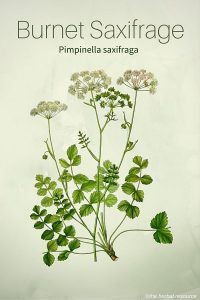The root contains an essential oil (up 0.4%), 1% saponins, bitter substances, tannin, polysaccharides, resin and the coumarins pimpinellin, bergapten and umbelliferone.
Burnet saxifrage has been used for a long time in folk medicine. The Greek physician Dioscorides (1st century AD) allegedly used the herb as a diuretic agent and the Danish physician Henrik Harp Strings (the 1200s) used the root against heart disease, edema, and cough.
The dried root is said to have an expectorant, anti-inflammatory, antispasmodic and mildly astringent effect. It is used to dissolve mucus in the airways and to treat cough, sore throat, bronchitis and other infections of the upper respiratory tract.
Extracts of the herb can be used as a gargle to reduce inflammation in the mouth and throat. Extracts and a decoction can be made both from water and alcohol.
Burnet saxifrage may also have diuretic properties and can work well for kidney and urinary tract disorders such as cystitis and stones in the urinary tract.
The herb has been used traditionally to stimulate milk production in lactating women.
When the herb is taken internally it may stimulate appetite and reduce the formation of intestinal gas. Additionally it is thought to be useful herb for diarrhea.
In the past, burnet saxifrage was used as a mild sedative and because of its antiseptic and healing properties, it was used topically as a treatment for wounds and other minor skin injuries.
The young leaves can be used as a component in mixed salads or as a garnish for cocktails. The leaves have a taste that is somewhat reminiscent of cucumber.
An essential oil is extracted from the seeds and is used to add flavor to sweets and to add a slightly bitter taste to liqueurs and pharmaceutical products.

Leave a Reply